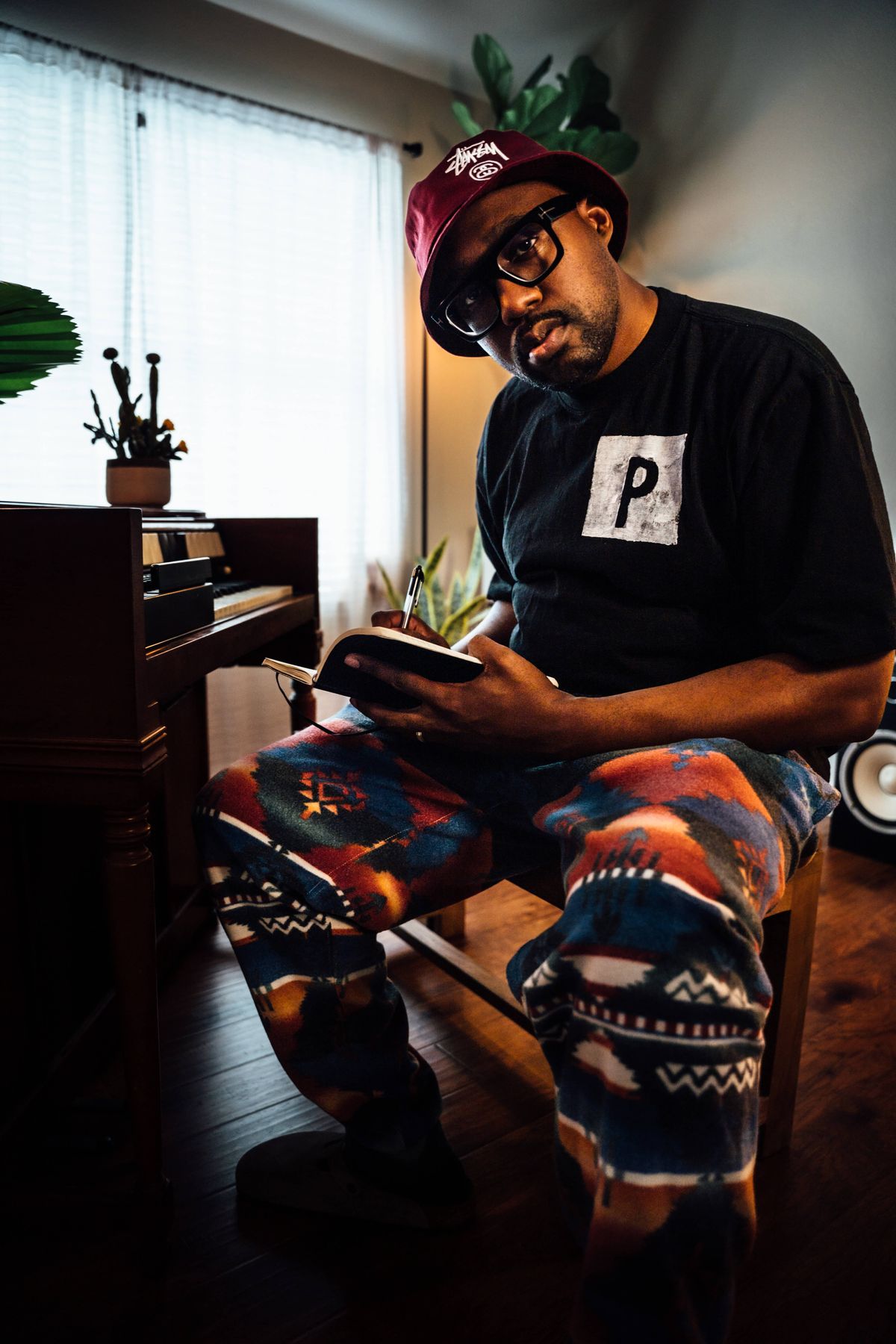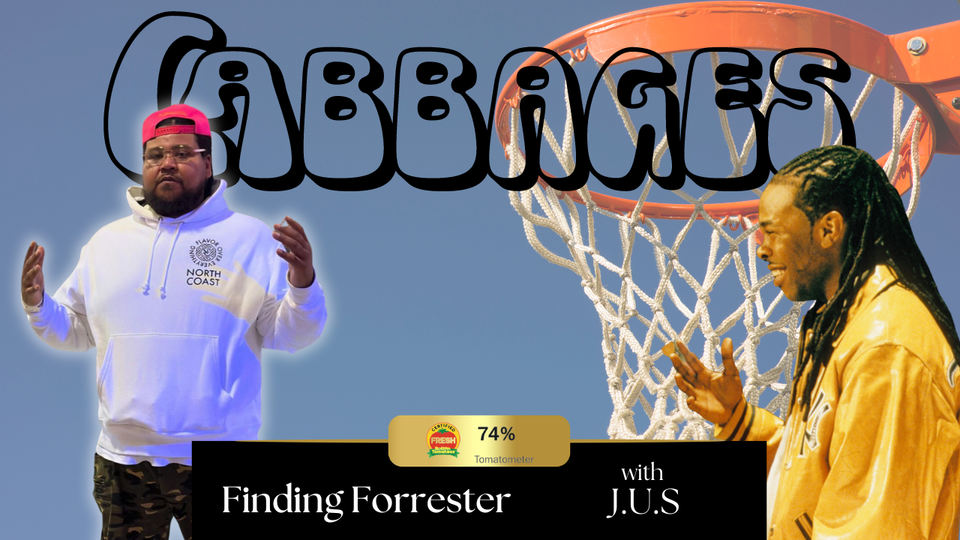Stik Figa Goes Home Again
Read the interview + reviews of Kohai the Wonderguy, Nappy Nina, and Oh No. This is CABBAGES #130

As an independent artist, Stik Figa has an enviable resume. Formerly of Mello Music Group, the rapper released multiple projects in the 2010s with then-obscure producers like L'Orange and Oddisee. Later, he worked closely alongside Conductor Williams, years before Westside Gunn added the beatmaker to his Griselda go-tos. All the while, he's retained a fierce sense of place in his work, waving the proverbial flag for a region that historically (and regrettably) hasn't received much national attention for its contributions to hip-hop.
Growing up about an hour's drive from Kansas City, MO, only to go on and become one of its rap scene's standout spitters, the Topekan moved to Fort Worth, TX just four years ago. Still, judging by the sounds and themes of his latest album Pookey: Stik Figa Finds Himself..., his hometown remains inextricably bound to him–both personally as well as artistically. "I remember telling my buddy I'm gonna name it Pookey," Stik Figa says. "He was like, oh, from New Jack City. But in my actual reality, this is really what my momma called me."
Produced by longtime friend and cohort DJ Sean P, the profound and revealing record's features overwhelmingly come from respected locals, including such notables as The Popper and Gee Watts. But perhaps the most meaningful contributions are by family, friends, and familiars, several of whom appear via messages and voice notes to remark on their native son as well as wider issues concerning masculinity and Blackness in America. "I wanted my actual family members, people I knew from my community, people who actually know me as an individual, to help recenter me and say, no, this is you," he says. "It helped me recalibrate who exactly I am, so that I could be better at expressing my ideas and my creativity."
Below are edited excerpts from our conversation.
Where does Pookey fit within the context of the wider Stik Figa discography?
Thematically, I've ended up making two distinct brands of what come from my mind and heart. There's the nostalgia-focused story of who I am; it's where I started before doing more, I would call them, experimental records. So the As Himself record or the Not [Quite] Himself–all of those are in the autobiographical documentary of who is this person? Who am I at the core? And then, The City Under The City, Heresy [with August Fanon], those are just me experimenting with allegory and writing styles. With Pookey, I want it to be an endcap for me to be talking about my upbringing. It's such a common theme and I don't want it to get old. I wanted to just bookend it and say, this is that story from 2012 when I was insecure and still figuring out where I stood with things.
I made [As Himself] when I was 24, and now I'm 40. The world's changed a lot, but not enough. I have a viewpoint that I don't have anymore from when I was in my twenties, that you have when you're now married with teenager children and living a very different life than you were then. I revisited that project and there's a lot of youthful energy that I enjoyed listening to. There's definitely a naïveté and a carefreeness in being kind of corny. I listen to songs like "Absitively." I used to play those at shows and the response was always twofold. It did pretty good at a show, and then sometimes I get off stage and people would be like, man, like I can't forget that song. But man, I do not like it. [laughs] I remember thinking, it's actually not great, but it's a lot of fun.
Then what set in was kind of like analysis paralysis. I got way more self-aware about myself from that point to this point where it was like, I don't wanna be, uh, expressing myself in this way. I wanna be taken serious in this way. So that's what one of the important themes of the new record was. And even though I said I had certain insecurities, I think this new record is more being finally comfortable in my own skin and expressing in a certain way how that journey played out for me in my formative, or my coming of age years, to present day, and how I've come to understand it all.
While writing and working on this project, were there times when you rethought or reconsidered some of your memories and experiences?
Absolutely. When you talk about pop culture, that's a real important part of it, because so much was either informed by what will be deemed acceptable. When you're young, you spend a lot of time thinking about the consensus. How will my friends, how will the block, this person you look up to, how will they respond to it? When you're young, that matters a lot more than when you're older, being able to talk to people who are older than me, from my community, about how even time has assisted them.
One of the important skits on there is called "A Wake Up Call." That's my OG, Pancho. In our small town in Topeka, he's one of them guys whose names used to come up mythically. You would hear these stories and you don't know what's true. Like, he fought five dudes in the bar or he was riding down Topeka Boulevard with a AK. He was that guy, and I get to have a conversation with him about who he really is and how he sees that life that he lived that, when I was young, thought was something to aspire to–even as an adult sometimes, I might even envy that I didn't participate–and getting his perspective, like, nah, it was bogus. It was reckless. The fact that I had to even sit down and do time to learn that was to my benefit–but also, I wish I didn't have to do that.
One of the things that I think you do really well on this project is on the track "OG," where you're sort of recontextualizing the term. Tell me a bit about that one.
A big deal about "OG," on a local level, is the sample is from Fat Tone, rest in peace, from Kansas City. That was his calling card, "OG Stack A Dolla." Not too long ago, there was a clip that went viral of a guy in Kansas City rapping Fat Tone while he getting locked up; so that's at the beginning of the record. We got my young life, A'Sean who's from Kansas City, a lot younger than me, but he's somebody that I admire and wanted to support. And then there's another OG, Popper, who is another, I wouldn't even say local legend but, again, one of those guys in the community that always looked up to when I was on my journey with rap; he just was dope and he was flooding Kansas City with stuff. Now he owns a store in the community. The way he rhymes his verse, he's laying it all out like, I reach people and I don't teach evil. He's laying out a very plain spoken understanding of what it means to do this.
Now that I'm 40, I get an opportunity to put A'Sean on a record. Then I get to do a callback to a record I was raised on. Then I get to put one of my heroes on it, all at the same time. And it's all Kansas City stuff. It's a complete representation of what this record coalesces too. Once you have these experiences, once you have this information, even if you could only reach back to home, this is what it's about: making a community effort. I can't put Freddie Gibbs on here–one cause I can't afford him, but two, he not from where I'm from. It wouldn't be authentic.
I have to ask about your working relationship with Conductor Williams. How has it changed or evolved over time? I imagine he's harder to pin down these days.
It's funny because we both came together in the Kansas City scene. I don't wanna speak for him, but when I was coming in I was in this "trying to be the best rapper in Kansas City" mentality. And he was like always thinking ahead of the scene, thinking beyond it. But whatever he saw of my talent, we were able to come together in like 2008, 2009 and just crank. We had really great chemistry and he's a great guy. That's my play cousin, as I say, how the homies be like, that's my cousin. We'd just crank records out; we worked hard.
What's really inspiring is that he hasn't changed anything about what he does. I can say that from firsthand experience. I'm gonna put this out there: there's a version of [Tyler, The Creator's] "SIR BAUDELAIRE" / [Westside Gunn's] "Michael Irvin" that I have. I was the first to rap on that. Their versions are better, but the fact that I was in the mix when it was happening was really interesting. Things were intersecting in this new way that I personally haven't experienced that side of the industry yet. When that started going, we still was working. During that time, we released Tomorrow Is Forgotten and Joyland. He's not harder to pin down; he's just a busy dude now. I don't know what that means for future records yet, but we still talk.
There's people who are fans of him exclusively, and there's people who are fans of Griselda exclusively. It's worked against me and for me. There's been times where people have heard my stuff and been like, this is whack, 'cause there's zero gun bars and zero cocaine being sold. <laugh> There's no weight. There's no boo-boo-boo-boo. But the few who get through the strainer are like, oh, this is hard, though. This is good.


Nappy Nina, Mourning Due
Quite a number of rappers of note turn to music as a means of contending with grief. Few, however, do so with such breathtaking artfulness as this Oakland-born, Brooklyn-based emcee does. Beginning with the literal dirtnap staged for the Mourning Due cover art, Nappy Nina approaches her themes with a special blend of confidence and trepidation. The fractured jazz and snatched snares behind "Whippin" offers whiffs of both, its virtual ride through the city haunted by absence–or at least difference. The disses of "Amen" and the reflections of "Cope" feel equally justified, her impossibly cool/calm delivery countered by off-kilter production. Joining her on this contemplative quest is an extraordinary assortment of vocalists whose presence adds dimensions to the album's world build. Moor Mother enters "Stone Soup" with a slam poet's crash course in nonlinear history while Stas THEE Boss lends her raspy wisdom to "Yes Yes Yes."
Oh No, Good Vibes
As deep as their special relationship goes, hip-hop and jazz don’t always afford one another a truly mutual respect. In the case of the former, specifically, the decades of sample plunder includes countless instances where the usage doesn’t do the source justice. This is where Oh No’s Good Vibes comes in to save the day. As he did before with the works of Rudy Ray Moore on the must-hear Ohnomite, the Oxnard, CA native interpreting the material as a scholar might sacred texts. And when one has been granted archival access to the music of vibraphonist Roy Ayers, one had best handle the contents with care. From the referential riffs and licks of "Penthouse Elevators" to the shimmering soul of "Another Two4," the results are somehow undeniably reverent while still remarkably inventive.
Kohai, the Wonderguy, Tales From Neo-Tokyo98
Known to those in-the-know as a DJ cohort of fine New Jersey rap misfits Fatboi Sharif and '89 The Brainchild, Kohai makes his return to the mic with this odd yet engaging set of tracks. For reference, think Flying Lotus in Captain Murphy mode, albeit less into jazz and even deeper in thrall to anime and gaming (and weed). So whether he's addressing his bedtime demons or simply spinning a good yarn, "Agent Of Sleep Paralysis" keeps you listening. The same goes for the restless "Kabukicho Syndrome (Stockholm)" and the far breezier "Wing Chun," both of which share terpenes and revel in grooves. The aforementioned Garden State guys guest in spots, with Mr. '89 and Sharif staying strange for "Aerial Assault" and "Fire Exit Signs," respectively.






